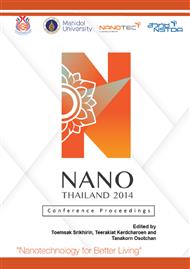[1]
V. A. Belyakov, V. A. Burdov, R. Lockwood, and A. Meldrum, Silicon Nanocrystals: Fundamental Theory and Implications for Stimulated Emission, Advances in Optical Technologies. 1 (2008) 1-32.
DOI: 10.1155/2008/279502
Google Scholar
[2]
H. Takagi, H. Ogawa, Y. Yamazaki, A. Ishizaki, and T. Nakagiri, Quantum size effects on photoluminescence in ultrafine Si particles, Applied Physics Letter. 56 (1990) 2379.
DOI: 10.1063/1.102921
Google Scholar
[3]
L. Pavesi, L. Dal Negro, C. Mazzoleni, G. Franzo, and F. Priolo, Optical gain in silicon nanocrystals, Nature. 408 (1990) 440-444.
DOI: 10.1038/35044012
Google Scholar
[4]
D. Kovalev, H. Heckler, G. Polisski, and F. Koch, Optical properties of silicon nanocrystals, Physica Status Solidi. B. 215 (1990) 871-932.
DOI: 10.1002/(sici)1521-3951(199910)215:2<871::aid-pssb871>3.0.co;2-9
Google Scholar
[5]
O. Serdar, James R. Chelikowsky, and Steven G. Louie, Quantum Confinement and Optical Gaps in Si Nanocrystals, Phys. Rev. Lett. 79 (2005) 1770-1773.
DOI: 10.1103/physrevlett.79.1770
Google Scholar
[6]
C. Bulutay. Interband, intraband, and excited-state direct photon absorption of silicon and germanium nanocrystals embedded in a wide band-gap lattice, Phys. Rev. B. 76 (2007) 205321-205334.
DOI: 10.1103/physrevb.76.205321
Google Scholar
[7]
K. Leung, and K. B. Whaley, Electron-hole interactions in silicon nanocrystals, Phys. Rev. B. 56 (1997) 7455-7468.
DOI: 10.1103/physrevb.56.7455
Google Scholar
[8]
S. Lee, L. Jonsson, J. W. Wilkins, G. W. Bryant, and G. Klimeck, Electron-hole correlations in semiconductor quantum dots with tight-binding wave functions, Phys. Rev. B. 63 (2001) 195318-195330.
DOI: 10.1103/physrevb.63.195318
Google Scholar
[9]
J. Thingna, B. R. Prasad, and S. Auluck, Photo-absorption spectra of small hydrogenated silicon clusters using the time-dependent density functional theory, Physics and Chemistry of Solids. 72 (2011) 1096-1111.
DOI: 10.1016/j.jpcs.2011.06.011
Google Scholar
[10]
A. Franceschetti, and A. Zunger, Direct Pseudopotential Calculation of Exciton Coulomb and Exchange Energies in Semiconductor Quantum Dots, Phys. Rev. Lett. 78 (1997) 915-918.
DOI: 10.1103/physrevlett.78.915
Google Scholar
[11]
F. A. Reboredo, A. Franceschetti, and A. Zunger, Dark excitons due to direct Coulomb interactions in silicon quantum dots, Phys. Rev. B. 61 (2000) 13073-13087.
DOI: 10.1103/physrevb.61.13073
Google Scholar
[12]
F. A. Reboredo, A. Franceschetti, and A. Zunger, Excitonic transitions and Exchange Spliting in Si Quantum Dots, Appl. Phys. Lett. 75 (1999) 2972.
DOI: 10.1063/1.125205
Google Scholar
[13]
M. V. Wolkin, J. Jorne, P. M. Fauchet, G. Allan, and C. Delerue, Electronic States and Luminescence in Porous Silicon Quantum Dots: The Role of Oxygen, Phys. Rev. Lett. 82 (1999) 197-200.
DOI: 10.1103/physrevlett.82.197
Google Scholar
[14]
I. Vasiliev, Optical excitations in small hydrogenated silicon clusters: comparison of theory and experiment, phys. stat. sol. (b). 239 (2003) 19-25.
DOI: 10.1002/pssb.200303242
Google Scholar
[15]
P. Vogl, H. P. Hjalmarson, and J. D. Dow, A semi-empirical tight-binding theory of the electronic structure of semiconductors, J. Phys. Chem. Solids. 44 (1983) 365-378.
DOI: 10.1016/0022-3697(83)90064-1
Google Scholar
[16]
A. Miranda, R. Vazquez, A. Diaz-Mendez, and M. Cruz-Irisson, Optical matrix elements in tight-binding approach of hydrogenated Si nanowires, Microelectronics Journal. 40 (2009) 456-458.
DOI: 10.1016/j.mejo.2008.06.018
Google Scholar
[17]
M. Zielinski, M. Korkusinski, and P. Hawrylak, Atomistic tight-binding theory of multiexciton complexes in a self-assembled InAs quantum dot, Phys. Rev. B. 81 (2010) 085301-085312.
DOI: 10.1103/physrevb.81.085301
Google Scholar
[18]
M. Korkusinski, O. Voznyy, and P. Hawrylak, Fine structure and size dependence of exciton and biexciton optical spectra in CdSe nanocrystals, Phys. Rev. B. 82 (2010) 245304-245319.
DOI: 10.1103/physrevb.82.245304
Google Scholar
[19]
L. W. Wang, and A. Zunger, Dielectric Constants of Silicon Quantum Dots, Phys. Rev. Lett. 73 (1994) 1039-1042.
DOI: 10.1103/physrevlett.73.1039
Google Scholar
[20]
T. Takagahara, and K. Takeda, Excitonic exchange splitting and Stokes shift in Si nanocrystals and Si clusters, Phys. Rev. B. 53 (1996) R4205-R4208.
DOI: 10.1103/physrevb.53.r4205
Google Scholar
[21]
S. Furukawa, and T. Miyasato, Quantum size effects on the optical band gap of microcrystalline Si: H, Phys. Rev. B. 38 (1988) 5726-5729.
DOI: 10.1103/physrevb.38.5726
Google Scholar


